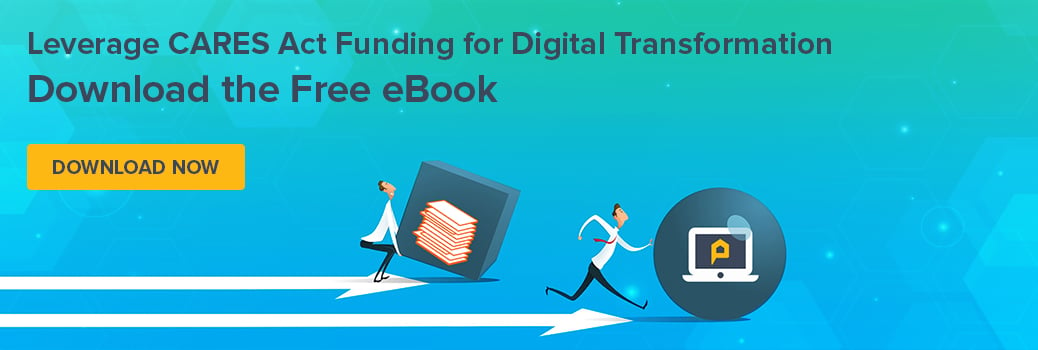The term, Digital Transformation gets a lot of use these days. Across industries the term is applied differently to various aspects of the tech world, from IT infrastructure, to big data, to machine learning. Generally speaking however, Digital Transformation marks a radical rethinking of how an organization uses technology, people and processes to fundamentally change business performance, according to George Westerman, an MIT principal research scientist.
Based on this definition, what specifically, what does Digital Transformation mean for local governments? Is it a worthwhile investment at a time of budget shortfalls brought on by a public health crisis? What are the desired outcomes of successful digital transformation for local government?
Mildred Warner, a professor of city and regional planning at Cornell University, recently said in an interview with Slate, “Government’s job is to be countercyclical to the economy, so at a time when you have a recession, that’s when you need to have government spending. We know what generated this recession: a pandemic, which will not last forever. We know it’s going to be short-term. And so we can reasonably make investments to get us through, knowing that it is going to be better on the other side. These are hard times. This is when you dip into your rainy day fund. This is when you take out savings. This is the time.”
For local governments, digital transformation is a worthwhile investment that is capable of unlocking significant benefits now and far into the future. While every project we work work on is different, broadly speaking, in the experience of the GovPilot team and our customers, effective digital transformation for a local government should be capable of delivering the following four general outcomes:
Convenient Constituent Experience:
We live in a digital world. As consumers we shop online, book travel online, order food through apps, pay our bills online, etc. It’s all done through the convenience of our screens while we sit at home or in a park, or an office. Constituents are consumers of government services, so it is frustrating for them to have to participate in a time consuming manual process when they deal with their local government… Taking time out of their day to fill out a paper form and submitting it in person at city hall, or mailing it in and waiting days for a response is not in line with the digital conveniences elsewhere in our modern society.
Effective digital transformation should result in happier, more informed, and satisfied constituents. Information should be easily accessible on a local government’s website, and the ability to submit applications, forms, and requests should be available as digital forms that can be filled out and submitted in a matter of clicks. Once submitted the constituent should receive a confirmation email and regular automated updates to keep them apprised of the status of their request. This saves considerable amounts of time and effort for both constituents and government employees alike.
Enhanced Efficiency and Productivity:
Critically, the digital forms and the data they capture should tie into a unified backend platform that organizes and makes records searchable for staff across all departments. There should NOT be a need for employees to have to manually re-enter information into a spreadsheet or single-use software platform, such is the case with many local governments that rely on fillable PDFs. This creates redundant work for employees, and fails to organize records in a searchable way, ultimately creating unnecessary work for staff - transposing, printing, copying, filing - that consumes valuable time and resources.
With a unified digital system in place, records across departments become instantly searchable, information is passed along quickly to colleagues, elected officials, and constituents without the need for phone calls, responding to mail, digging through physical archives, or physically walking from office to office. The elimination of manual processes leads to hours in time savings per day for employees that can be dedicated to other critical tasks.
To better understand what increased efficiency and productivity can do for your government visit GovPilot’s Case Study page.
Business Continuity:
Do employees need to be in the office at their desks in order to complete their work? Do they need to log in to an on-site server? How about constituents - do they need to be physically present in city hall to submit documents?
What were to happen if a snowstorm, flood, hurricane, ransomware attack, or a global pandemic forced government buildings to close or occupancy levels limited for days, weeks, or months at a time? Could employees continue their work regardless of their location? Could constituents submit requests or documents? Would services still be delivered?
Effective digital transformation ensures business continuity through any and all disruptions which require that government offices be closed to employees and/or the public.
Cloud based software, like GovPilot, is accessible anywhere from any device, at any time. This means that a constituent can submit a permit application at 11pm from their home computer, and a government employee can process that application instantly from their personal device in their own home if need be. Government business will not grind to a halt if government buildings are inaccessible. Business continuity is critical to the delivery of services, the generation of revenue, and the satisfaction of constituents, elected officials, and employees.
In a world of uncertainties and increasing disruptions, business continuity planning is essential, and cloud-based solutions offer the most flexibility and adaptability to keep government operations and services running.
See how Jackson, New Jersey ensured business continuity by adopting GovPilot during the COVID-19 Pandemic.
Cost Savings and Revenue Generation:
The information processed and recorded through a unified digital platform such as GovPilot’s, will provide the data and insights necessary to make informed decisions about how and where savings can be achieved. The increased efficiency and productivity gained by eliminating manual paper processes might mean that employees once responsible for time-consuming work can now be deployed elsewhere.
Digital records can also reveal revenue opportunities through the detection of past-due or renewal fees for items like pet licenses, parking permits, and alarm registrations, which can generate significant sums over the course of a fiscal year.
Lastly, online payment directly through a government’s website, translates to instant revenue and confirmation that services have been paid for. No longer is there a need to manually process check or cash payments that are mailed in, or dropped off in-person, which can significantly delay or hinder collection.
Conclusion:
The world in which we live is one that relies on data, speed, and convenience. Constituents expect a fast, responsive experience. Disruptions that threaten business continuity are increasing in frequency and magnitude. The decades old manual processes that local governments have relied upon to provide services to their constituents no longer keep up with the pace and expectations of the modern world. In fact, these manual processes represent a liability to local governments in terms of cost, efficiency, and reliability.
Digital Transformation is an investment that local governments must make in order to keep pace with the growing demands placed upon them. GovPilot stands ready as a trusted partner in that process. Consider scheduling a 15-minute consultation to discuss your questions, concerns, and goals with one of our Solutions Specialists.







